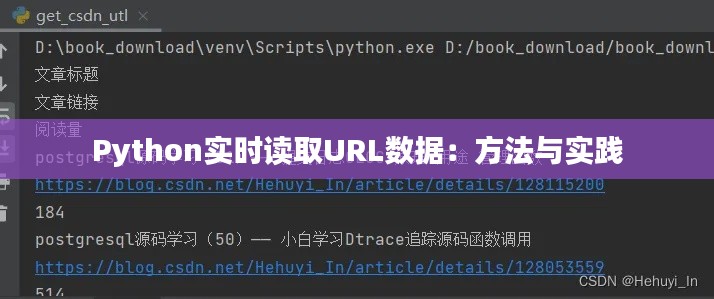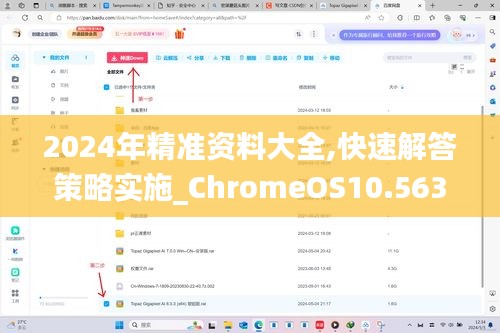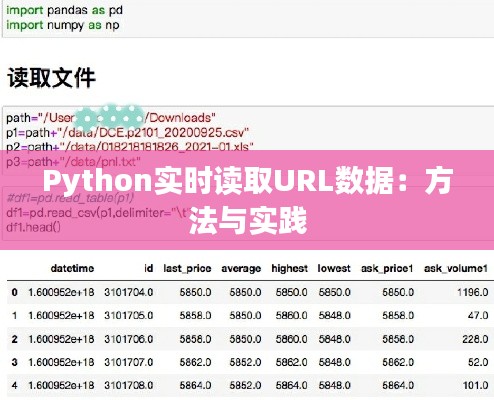标题:Python实时读取URL数据:方法与实践
引言
在当今数据驱动的世界中,实时获取和解析网络上的数据变得尤为重要。Python作为一种功能强大的编程语言,在处理网络数据方面具有显著优势。本文将探讨如何使用Python实时读取URL数据,并介绍几种常用的方法和实践。
一、使用Python标准库
Python的标准库中包含了一些用于网络请求的模块,如urllib和http.client。这些模块可以用来发送HTTP请求并获取URL的数据。
1. 使用urllib.request
import urllib.request
def fetch_url(url):
with urllib.request.urlopen(url) as response:
return response.read()
# 示例
url = "http://example.com"
data = fetch_url(url)
print(data)2. 使用http.client
import http.client
def fetch_url(url):
conn = http.client.HTTPConnection("www.example.com")
conn.request("GET", "/")
response = conn.getresponse()
data = response.read()
conn.close()
return data
# 示例
url = "http://example.com"
data = fetch_url(url)
print(data)二、使用第三方库
除了Python标准库外,还有一些第三方库可以简化网络请求和数据处理的过程。
1. 使用requests
requests是一个简单易用的HTTP库,可以发送各种HTTP请求。
import requests
def fetch_url(url):
response = requests.get(url)
return response.text
# 示例
url = "http://example.com"
data = fetch_url(url)
print(data)2. 使用aiohttp
对于需要异步处理网络请求的场景,aiohttp是一个不错的选择。
import aiohttp
async def fetch_url(url):
async with aiohttp.ClientSession() as session:
async with session.get(url) as response:
return await response.text()
# 示例
import asyncio
url = "http://example.com"
loop = asyncio.get_event_loop()
data = loop.run_until_complete(fetch_url(url))
print(data)三、实时读取URL数据
在实际应用中,我们可能需要实时地读取URL数据,例如监控某个网站的变化。以下是一些实现方法:
1. 定时轮询
通过定时轮询的方式,定期检查URL数据的变化。
import time
import requests
def fetch_url(url):
response = requests.get(url)
return response.text
def monitor_url(url, interval=60):
while True:
data = fetch_url(url)
print(data)
time.sleep(interval)
# 示例
url = "http://example.com"
monitor_url(url)2. 使用WebSocket
WebSocket允许全双工通信,可以实现实时数据传输。
import websocket
def on_message(ws, message):
print("Received message: " + message)
def on_error(ws, error):
print("Error: " + str(error))
def on_close(ws):
print("### closed ###")
def on_open(ws):
def run(*args):
for i in range(3):
time.sleep(1)
ws.send("Hello %d" % i)
ws.close()
print("Thread terminating...")
thread = threading.Thread(target=run)
thread.start()
if __name__ == "__main__":
websocket.enableTrace(True)
ws = websocket.WebSocketApp("ws://echo.websocket.org/",
on_message=on_message,
on_error=on_error,
on_close=on_close)
ws.on_open = on_open
ws.run_forever()结论
本文介绍了使用Python实时读取URL数据的方法和实践。通过使用Python标准库和第三方库,我们可以轻松地发送HTTP请求并获取URL数据。在实际应用中,根据需求选择合适的方法和工具,可以有效地实现实时数据监控和数据处理。
转载请注明来自云南良咚薯业有限公司,本文标题:《Python实时读取URL数据:方法与实践》












 滇ICP备2021007469号-1
滇ICP备2021007469号-1